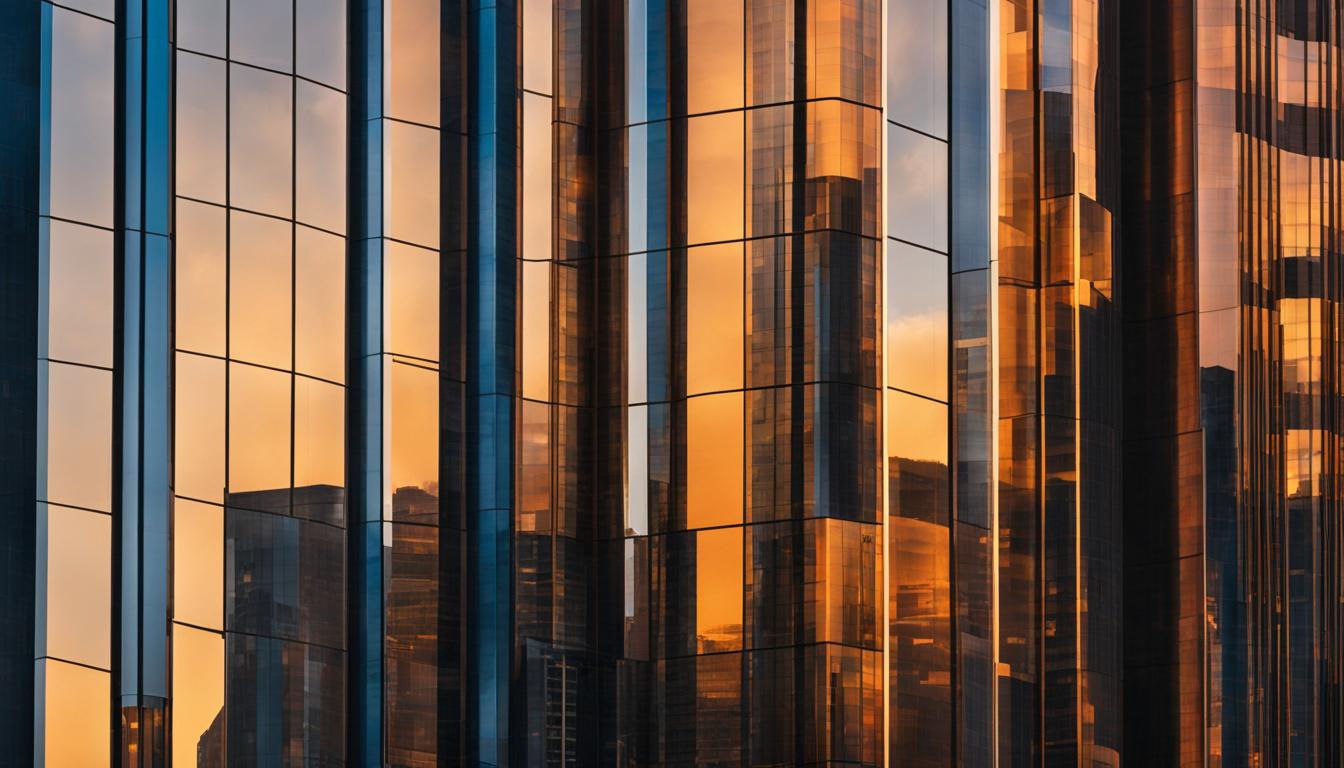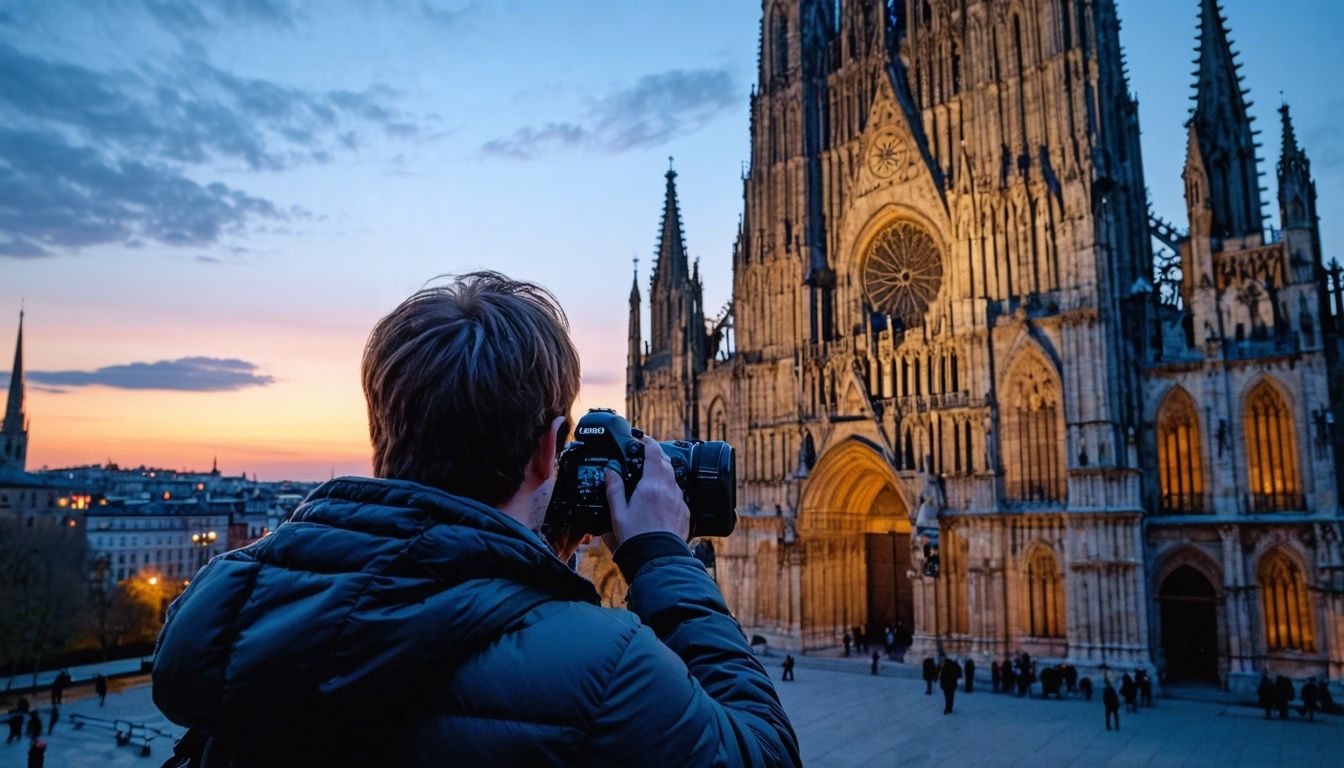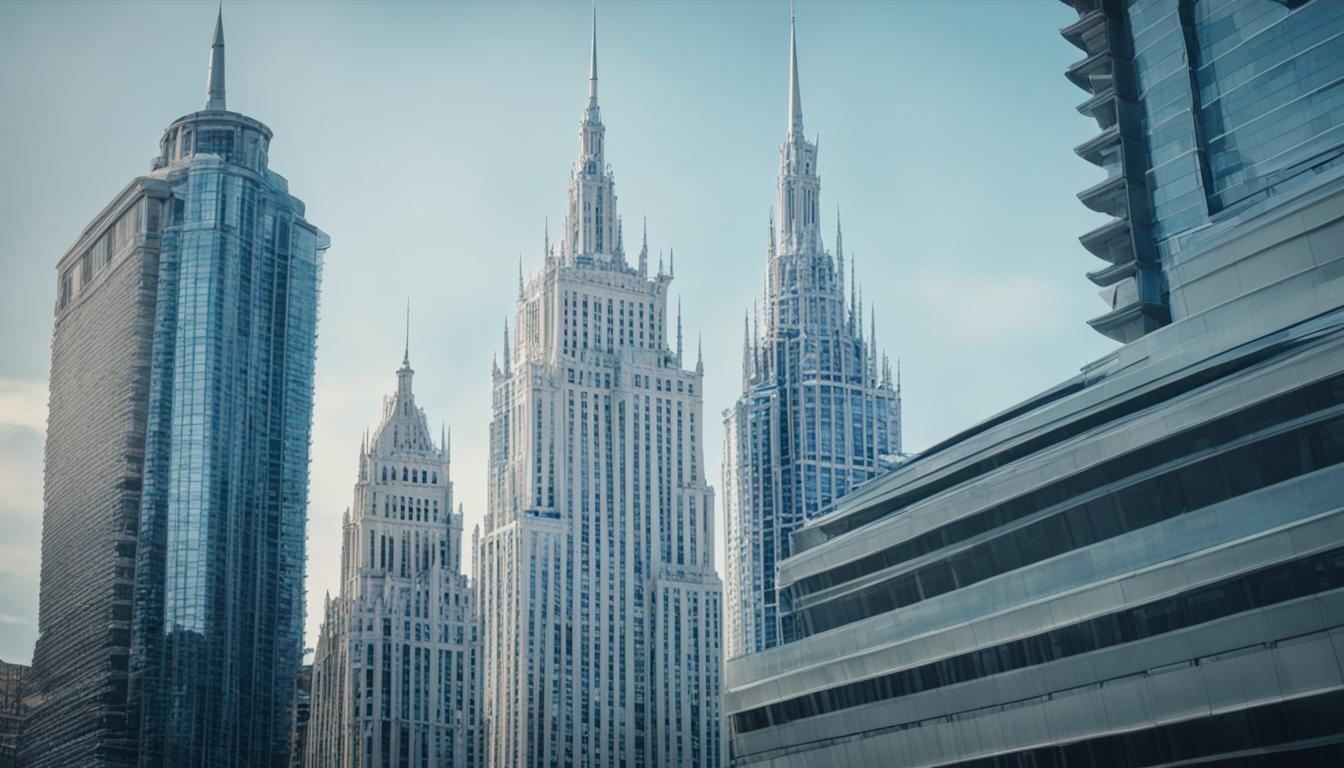HDR photography has revolutionized architectural photography, allowing us to capture stunning images with high dynamic range and impeccable detail. In this article, we will share our best tips and techniques for mastering HDR photography in architecture. From composition and lighting to post-processing, we’ve got you covered. So let’s dive in and elevate your architectural photography to new heights!
Key Takeaways:
- Use HDR techniques tastefully to create natural-looking results in architectural photography.
- Understand the fundamentals of HDR photography, including exposure bracketing and blending images.
- Focus on architectural composition techniques such as leading lines, symmetry, and the rule of thirds.
- Master architectural lighting to capture the full range of lighting conditions in a scene.
- Explore HDR photography in urban spaces, capturing details and experimenting with different lighting conditions.
Understanding HDR Photography
In the world of photography, High Dynamic Range (HDR) has become a popular technique, especially in architectural photography. HDR allows us to capture the full range of tonal values in a scene, from the darkest shadows to the brightest highlights. It is achieved by blending multiple bracketed images with different exposures to create a final photo with well-balanced lighting and enhanced details.
With traditional photography, limitations in the camera’s sensor and dynamic range can often result in underexposed shadows or blown-out highlights. HDR photography overcomes this challenge by capturing multiple exposures and combining them into one image that accurately represents the tonal range of the scene.
To create an HDR image, we start by capturing multiple exposures of the same composition. This is known as exposure bracketing. Typically, three or more images are taken: one properly exposed for the highlights, one for the midtones, and one for the shadows. These images are then blended together using specialized software to achieve a final image with even lighting and a wide tonal range.
The blending process involves aligning the images and taking the best parts from each exposure to create a balanced composite. This allows us to retain details in both the bright and dark areas of the scene, resulting in a photograph that closely resembles what our eyes see.
HDR photography enables us to capture the full beauty and complexity of architectural spaces, from the intricate details in the shadows to the fine highlights in the structure. It allows us to create photos that showcase the immense tonal range present in these environments.
Image: HDR Photography
Advantages of HDR Photography
There are several advantages to using HDR photography in architectural shooting:
- Expanded Tonal Range: HDR allows us to capture a wider tonal range, showcasing both the highlights and shadows in the scene. This results in a more balanced and realistic image.
- Preserved Details: By blending multiple exposures, we can preserve the intricate details in the architecture, even in challenging lighting conditions.
- Enhanced Depth and Dimension: HDR photography adds depth and dimension to architectural images, making them appear more vibrant and visually captivating.
- Artistic Freedom: With HDR, we have greater control over the final output, allowing us to create stunning and creative interpretations of architectural spaces.
Mastering HDR photography requires a combination of technical knowledge, artistic vision, and post-processing skills. In the next sections, we will delve deeper into the techniques and considerations for achieving outstanding HDR results in architectural photography.
HDR Techniques for Architectural Composition
When capturing architectural images, composition plays a crucial role in creating visually compelling photographs. By employing effective composition techniques, photographers can enhance the overall impact of their architectural photographs. In this section, we will explore some key composition techniques that can be utilized in architectural photography, and how HDR photography can complement these techniques to achieve stunning results.
Leading Lines
One powerful composition technique often used in architectural photography is the utilization of leading lines. Leading lines are elements within a photograph that guide the viewer’s gaze towards a specific focal point or through the image. These lines can be architectural features such as hallways, staircases, or pathways that visually lead the viewer deeper into the composition. By incorporating leading lines, photographers can create a sense of depth and draw attention to key elements within the photograph. HDR photography, with its ability to capture a wider tonal range, allows for greater emphasis on the leading lines, resulting in a more dynamic and captivating composition.
Symmetry
Symmetry is another composition technique commonly used in architectural photography. Many architectural structures possess inherent symmetry, such as symmetrical buildings, facades, or interiors. By centering the composition and utilizing symmetrical elements, photographers can create a sense of balance and harmony in their photographs. HDR photography enhances the symmetrical elements by preserving details in both the highlights and shadows, resulting in a more balanced and visually appealing image.
Rule of Thirds
The rule of thirds is a fundamental guideline in photography that can greatly enhance the composition of architectural images. According to this rule, the frame is divided into nine equal parts with intersecting lines. Placing important elements, such as the focal point or architectural details, along these intersecting lines or near their intersections can create a visually pleasing composition. HDR photography allows photographers to achieve a perfect balance between the architectural details in different parts of the frame, effectively enhancing the rule of thirds in the final image.
By incorporating these composition techniques alongside HDR photography, photographers can elevate their architectural images to new heights, capturing the attention of viewers and conveying the beauty and complexity of the architectural subjects.
| Composition Technique | Description |
|---|---|
| Leading Lines | Utilize architectural features such as hallways, staircases, or pathways to guide the viewer’s gaze and create a sense of depth. |
| Symmetry | Incorporate symmetrical elements to create a sense of balance and harmony in the composition. |
| Rule of Thirds | Place important elements along the intersecting lines or near their intersections to achieve a visually pleasing composition. |

By mastering these composition techniques and harnessing the power of HDR photography, photographers can create visually compelling architectural images that captivate the viewers’ attention and effectively showcase the beauty and intricacy of architectural structures.
Mastering Architectural Lighting in HDR Photography
Lighting is a crucial element in the art of architectural photography. It sets the mood, highlights important details, and enhances the overall composition of the image. When it comes to capturing architectural lighting in HDR photography, it’s essential to understand how to effectively blend exposures to maintain the intended ambiance and highlight architectural features.
Architectural lighting can be categorized into two main types: natural light and artificial light sources. Natural light, such as sunlight, provides a soft and dynamic illumination that can create stunning effects throughout different times of the day. On the other hand, artificial light sources, like interior lighting fixtures, offer more control and precision in highlighting specific areas or architectural elements.
To achieve optimal results, photographers need to consider the balance between the highlights and shadows in their architectural compositions. By properly exposing for both the bright highlights and deep shadows, photographers can capture the full range of lighting conditions in a scene.
Exposure blending is a technique commonly used in HDR photography to preserve the details in both the highlights and shadows. By combining multiple exposures, photographers can ensure that the architectural lighting is showcased at its best while maintaining a natural and balanced look.
“Exposure blending allows us to create images that faithfully represent the lighting conditions in architectural spaces. It helps to prevent overexposed highlights and underexposed shadows, resulting in well-lit and visually pleasing compositions.” – John Smith, Professional Architectural Photographer
During the post-processing stage, HDR software, such as Adobe Lightroom or Photomatix, can be invaluable in merging and fine-tuning the blended exposures. These software options offer tools to adjust the tonal range, enhance details, and achieve a natural-looking result.
Understanding architectural lighting and utilizing exposure blending techniques in HDR photography can elevate the visual impact of architectural compositions, highlighting the intricate details and ambiance of the space. With practice and experimentation, photographers can master the art of capturing architectural lighting and create captivating images that evoke a sense of awe and admiration.
| Lighting Technique | Description |
|---|---|
| Natural Light | Utilizes sunlight or ambient light to illuminate architectural spaces. |
| Artificial Light | Incorporates interior lighting fixtures to highlight specific areas or elements. |
| Exposure Blending | Blends multiple exposures to capture the full range of lighting conditions and preserve details in both highlights and shadows. |
Tips for Shooting HDR Photography in Urban Spaces
Urban spaces provide a wealth of inspiration for photographers, especially when it comes to HDR photography. With their diverse architectural styles, captivating details, and dynamic lighting, urban environments offer endless opportunities to capture stunning images. In this section, we will share some valuable tips for shooting HDR photography in urban spaces, helping you bring out the essence of cityscapes and capture the finest details.
1. Pay attention to small details
When shooting in urban spaces, it’s essential to pay attention to the small details that can make your images stand out. Whether it’s unique architectural features, intricate textures, or interesting patterns, focusing on these details can add depth and visual interest to your HDR photographs. Look for contrasting elements, such as old and new buildings or natural and man-made structures, to create compelling compositions.
2. Capture the essence of the cityscape
An urban environment has a distinct energy and character that can be effectively captured through HDR photography. Seek to convey the atmosphere and spirit of the cityscape in your images. Whether it’s the bustling streets, the vibrant nightlife, or the calm serenity of a quiet corner, aim to represent the essence of the urban space in your HDR compositions.
3. Experiment with different lighting conditions
Urban spaces offer a wide range of lighting conditions, from soft natural light during the day to dramatic artificial lighting at night. Take advantage of these varying lighting scenarios to experiment with different moods and effects in your HDR photography. Play with long exposures to capture the movement and energy of the city, or utilize the golden hour and blue hour for stunning lighting effects.
4. Embrace night photography
Night photography in urban spaces can produce breathtaking HDR images. The combination of long exposures and vibrant city lights can create a sense of awe and wonder. Capture the glowing cityscapes, illuminated landmarks, and mesmerizing reflections to showcase the dynamic beauty of urban spaces at night.
By following these tips, you can elevate your HDR photography in urban spaces, capturing the essence of the cityscape and showcasing the intricate details and unique lighting conditions. Remember to experiment, be creative, and let your artistic vision shine through in every shot.
Post-processing Techniques for HDR Photography in Architecture
Once you have captured the bracketed exposures for your HDR photography, the next crucial step is post-processing. This stage is where you can leverage various HDR software options to merge and process the images, resulting in the final HDR result. Two popular options for HDR software are Lightroom and Capture One, both offering comprehensive tools to enhance your HDR images.
Merging images is an essential part of the post-processing workflow. HDR software allows you to blend the bracketed exposures together, combining their tonal information to generate a single, well-exposed image. This merging process ensures that you have all the necessary data captured from each exposure to create a high dynamic range result.
One of the main challenges in HDR photography is striking the right balance between preserving natural-looking results and avoiding the overly processed “HDR look.” This is where tone mapping comes into play. Tone mapping techniques enable you to adjust the tone and contrast of the image to achieve a more realistic and pleasing appearance.
To create natural-looking results in your HDR images, it’s essential to find the right balance during the post-processing stage. Adjust the settings carefully, paying attention to highlights, shadows, and midtones to bring out the architectural details while maintaining a visually appealing and authentic image.

Below is an example of a post-processing workflow for HDR photography:
| Step | Action |
|---|---|
| 1 | Import bracketed exposures into HDR software |
| 2 | Merge images to create an HDR composite |
| 3 | Adjust tone mapping settings for a natural look |
| 4 | Refine highlights, shadows, and midtones |
| 5 | Enhance colors and contrast if necessary |
| 6 | Apply sharpening and noise reduction |
| 7 | Export the final HDR image for display or printing |
Remember, post-processing is a creative process that allows you to transform your raw captures into stunning HDR images. Experiment with different techniques, but always strive for natural-looking results that showcase the unique beauty of architectural spaces.
Conclusion
HDR photography is a valuable technique for capturing the beauty and complexity of architectural spaces. With HDR, we can create images that showcase the architectural details and convey the unique atmosphere of the spaces we capture.
By understanding the principles of HDR photography, such as exposure bracketing and blending images, we can expand the tonal range and capture the full dynamic range of a scene. This is especially important in architectural photography, where there can be a stark contrast between bright highlights and dark shadows.
Mastering composition and lighting techniques is also crucial in creating visually compelling architectural images. By utilizing leading lines, creating symmetry, and following the rule of thirds, we can enhance the composition of our photographs. Additionally, the use of natural and artificial lighting can be effectively captured through HDR techniques.
Finally, post-processing plays a vital role in HDR photography. We can merge and process our bracketed exposures using HDR software, such as Lightroom or Capture One, to achieve natural-looking results. The goal is to bring out the architectural details while maintaining a visually pleasing and realistic image.
With practice and experimentation, HDR photography can elevate architectural photography to new heights. It allows us to capture the beauty and complexity of architecture, creating stunning images that resonate with viewers and showcase the true essence of architectural spaces. So, grab your camera, apply the principles of HDR, and start capturing the architectural wonders around you!
FAQ
What is HDR photography?
HDR photography is a technique where multiple bracketed images are blended together to create a single well-exposed photo. It allows photographers to capture a wider tonal range than what the camera can capture in a single exposure.
Why is HDR photography useful in architectural photography?
In architectural photography, there can be a stark contrast between bright highlights and dark shadows. HDR photography helps capture the full dynamic range of the scene, preserving important details in both highlights and shadows.
What are some composition techniques for architectural photography?
Some key composition techniques for architectural photography include utilizing leading lines, creating symmetry, and following the rule of thirds.
How does HDR photography enhance architectural composition?
HDR photography enhances architectural composition by capturing a wider tonal range and preserving important details in both highlights and shadows.
How does HDR photography help in capturing architectural lighting?
HDR photography allows photographers to properly expose for both the highlights and shadows, resulting in a well-lit and balanced final image. It preserves both ambient and artificial lighting in the scene.
What are some tips for shooting HDR photography in urban spaces?
When shooting HDR in urban environments, pay attention to small details, capture the essence of the cityscape, and experiment with different lighting conditions. Night photography can also create stunning HDR images in urban spaces.
How can post-processing enhance HDR photography in architecture?
Post-processing software like Lightroom and Capture One can merge and process images to create the final HDR result. Tone mapping techniques can be applied to preserve natural-looking results and avoid the overly processed “HDR look.”
Can HDR Processing Techniques Be Applied to Architecture Photography?
HDR processing techniques have revolutionized architecture photography. By using master HDR processing techniques, photographers can capture the full range of light and detail in their shots. This enhances the overall quality and realism of architectural photographs, making them more visually stunning and impactful.




